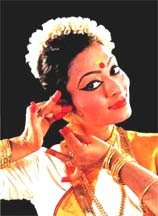Apr 19, 2024
Apr 19, 2024
 Mohiniattam is one of the most lyrical classical dance forms of India, originating from Kerala. The word Mohini stands for an enchantress, a beautiful woman who seduces others for a particular purpose. Attam means dance. So Mohiniattam is the dance of the enchantress.
Mohiniattam is one of the most lyrical classical dance forms of India, originating from Kerala. The word Mohini stands for an enchantress, a beautiful woman who seduces others for a particular purpose. Attam means dance. So Mohiniattam is the dance of the enchantress.
The earliest known textual reference about Mohiniattam is found in a commentary on the Vyavaharamala, a Sanskrit text written by Mazhamangalam Namboodiri during the 16th century. In the commentary believed to be authored by a migrated Brahmin scholar of Kerala, the word for dancers was translated as Mohiniattam artistes etc. Another reference on Mohiniattam can be found in the Ottanthullal (a semi-classical and semi-folk dramatic art form of Kerala) script Ghoshayatra, authored by Kunchan Nambiar during the 2nd half of the 18th century.
Perhaps Mohiniattam is the only dance form of India that was subject to several revivals and renaissance. Some scholars believe that like Bharatanatyam, Mohiniattam too was associated with devadasi tradition and other scholars think Mohiniattam was a dance form performed by women but not associated with devadasi system.
Whatever it is, for several reasons the male members of the affluent and powerful Namboodiri and Nair families exploited the Mohiniattam dancers. Gradually the dance was considered inappropriate and there were few takers for it. The efforts of Maharaj Swathitirunal (1813-1846) and the attempts of Kerala poet laureate Vallathol Narayana Menon, in 1932, 1937 and in 1950, to revive Mohiniattam are important endeavors which are now considered as crucial chapters in the history of this art.
The tradition of this dance form sustained through the contributions of two veterans, Guru Kalyanikutti Amma and Guru Satyabhama. While Guru Kalyanikutty Amma's was an effort at her individual level, Guru Sathyabhama got the platform of the Kerala Kalamandalam, where since 1957, until her retirement as its Principal in 1993, she was faculty.
While dance forms like Bharatanatyam and Odissi attained both national and international significance until recently Mohiniattam was sidelined. There are a few reasons behind this.
Now, slowly Mohiniattam started getting its due share in both the national and international performing scene. The identity of sopana sangeetam (Kerala music) as the music of Mohiniattam is recognized. New dancers made remarkable attempts to delineate the art from following the heels of Bharatanatyam, by choreographing new items. Jayadeb's ashtapadi got an eternally alluring charm in Mohiniattam stage.
Scholar-poet and theatre thespian Kavalam Narayana Panicker came forward with new compositions and researched theories to put Mohiniattam back to its rail, duly freeing it from imitating the Bharatanatyam repertoire, by emphasizing on the aesthetics and ethnic influence of the art form. Artists like Kanak Rele and Bharati Shivaji took initiative to take it to more and more platforms.
While thinking on the aesthetics of an art form, one cannot afford to overlook the ethnic or regional touches of the art form. No doubt, the change in the coiffure of the dance form to give it more a Kerala touch was a remarkable contribution in this direction. The change in the hairstyle to give the Mohini a typical Kerala touch was done at the platform of the Kalamandalam under the initiation of Guru Kalamandalam Sathyabhama.
Kondakettal (hair being bunched upon the left side of the head with strands of jasmine flowers circling it) was accepted as the coiffure of the art form. In any old picture of traditional Kerala women one can see this coiffure, let alone the royal women in Ravi Varma paintings.
Generally, for Mohiniattam off-white dresses with golden/colored borders are used. Very limited attempts are made so far to make the costume more attractive which is one of the important aspects of any dance form to satisfy the visual needs of the rasikas (audience).
Even though now a day all rasas have been used for Mohiniattam items, the basic Rasa of Mohiniattam are Sringara (eroticism) Bhakti (devotion). The basic tempo is lasya, highly feminine movements. Hence, as far as the body language of the art is concerned it is equally important to consider both what should be done and what should not be done.
Now, gradually, Mohiniattam started getting its due share both at the national and international performing scene. Art lovers and connoisseurs started recognizing the performance potential and significance of Mohiniattam. Mohiniattam is getting the long deserving recognition in lead festivals of the country, especially outside Kerala.
Pallavi Krishnan, a leading exponent of Mohiniattam is Artistic Director & Managing Trustee of Lasya Academy of Mohiniattam at 'Lasya-Charulata', 16th St. Hari Nagar, Punkunnam,
Thrissur - 680 002, Kerala, India. Tel: 91-487-2381584 & 91-33-25482217
Email: lasya@vsnl.com
08-Mar-2001
More by : Pallavi Krishnan

|
A very interesting and informative article revealing the history of Mohiniattam,Very useful for dance students indeed. Thank you very much Pallavi ji. |